While much is said about the personalities of betta fish, did you also know that they are expert bubble blowers These fish are master builders, constructing nests that can consist of hundreds of little Bubble Nest What are the reasons behind bubble nests and how do bettas make them? Keep reading to find out.
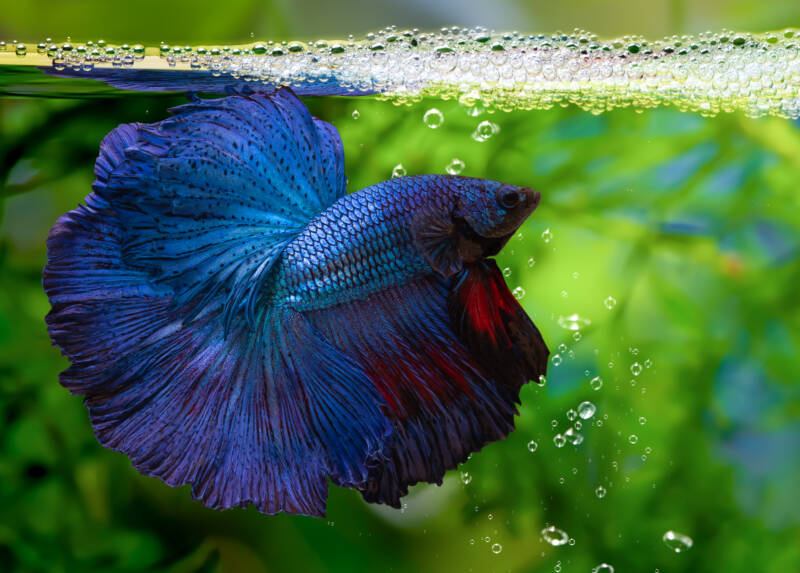
[toc]
What is a Bubble Nest?
When it comes time to bear young, numerous species throughout the animal kingdom build nests in preparation.
Nests provide a safe place in which to incubate eggs and raise newly hatched young.
The construction of these nests varies greatly depending on the type of animal and the resources available in the animal’s environment.
For the betta fish, their resources are oxygen and their own saliva, which they combine to blow tiny, long-lasting bubbles that stick together.
The resulting formation is perfect for the betta’s aquatic habitat, allowing a confined space for the eggs to mature and a protected space for the baby betta fish, or fry, to develop.
What Does a Betta Bubble Nest Look Like?
A bubble nest appears as a cluster of bubbles at the water surface.
These nests vary in size and thickness depending on the individual betta fish.
Some fish construct nests only a few inches in size, consisting of a couple dozen bubbles.
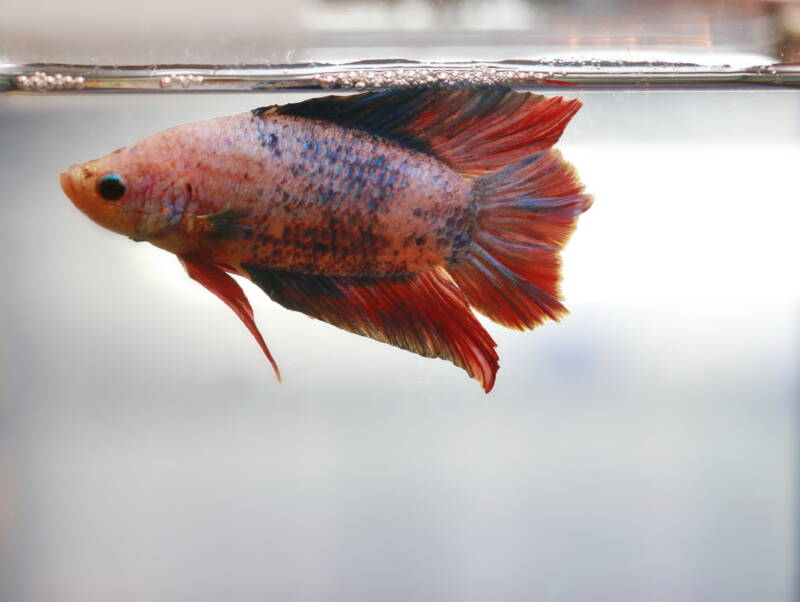
Enterprising bettas can build nests reaching several inches in length, composed of hundreds of bubbles.
There may or may not be depth, or layers, to these formations. The bubbles themselves can vary in individual size and be larger, smaller, or even foamy in appearance.

Bubble nests may incorporate floating debris or plant material to use as an anchor.
Conversely, they can simply be floating in a corner of the tank.
Basically, if you have a healthy male in your tank and you see a collection of bubbles, it is likely that your male has built a bubble nest.
How is the Bubble Nest Made?
Betta fish are adapted to intake oxygen directly from the air, as opposed to other fish species that filter it from the water.
Bettas can do this because they possess a special organ called the labyrinth organ.
Labyrinth organs consist of bony plates covered in a thin membrane.
The arrangement of these plates, called lamellae, resembles a maze, and as air is drawn in, it passes through the membrane and into the fish’s bloodstream.
This is an extraordinarily helpful adaptation for fish that live in shallow waters, where the oxygen levels can drop.
Blowing Bubbles
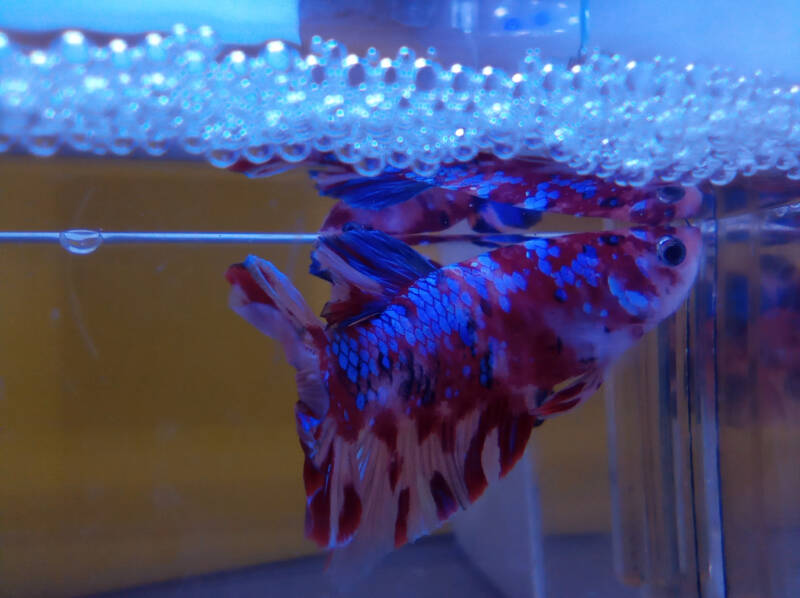
It is the male betta that makes the bubble nest.
The male will go to the surface, draw in air using his labyrinth organ, and blow out a saliva-covered bubble.
The saliva coating keeps the bubbles from popping quickly and binds the individual bubbles together.
While long lasting, these bubbles will eventually degrade and burst.
As such, the male must regularly maintain the nest by intaking air and blowing more bubbles.
If you have never owned a betta fish previously, you may be surprised by how frequently they scoot up to the surface for a gulp of air.
This is perfectly normal behavior for betta fish and aids in their ability to build bubble nests.
Note, however, if your fish is spending most of its time at the surface, it may indicate that your water quality is poor, so check those parameters and adjust as needed.
When Do Betta Fish Build Bubble Nests ?
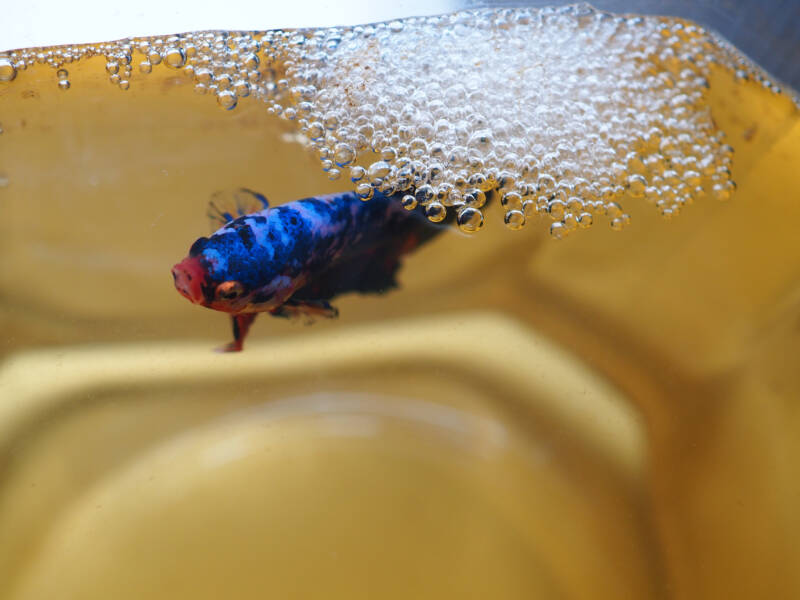
The bubble nest is an integral part of the betta breeding process.
When it is time to reproduce, the male betta constructs the nest to impress the female and encourage her to mate.
Interestingly, if the female is not ready or if the bubble nest is not built to her satisfaction, she may swim through the nest and destroy it, prompting the male to begin construction again!
If the nest is accepted, the male will begin to court the female by dancing while flaring his fins and gills.
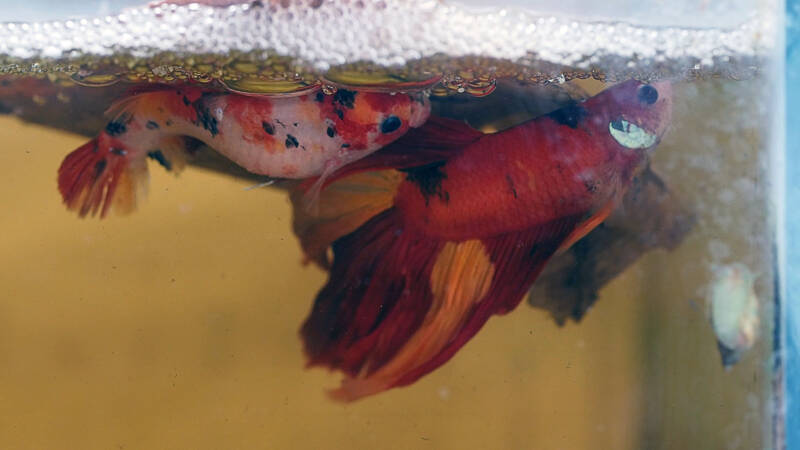
The mating process continues with the male embracing the female and fertilizing the eggs as she releases them.
A female will typically spawn around 50 eggs, but the number can be higher.
The fertilized betta eggs will then drop to the substrate. The male gently gathers them and places them in the bubble nest, where they will be protected as they develop.
Male Betta Fish Protects the Eggs
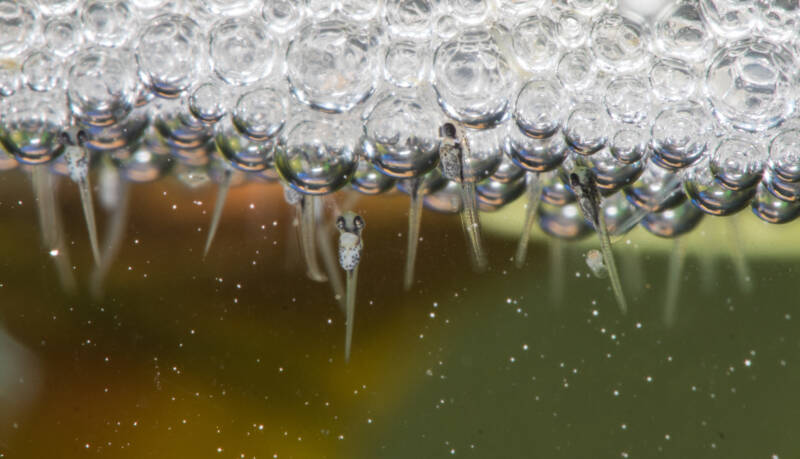
During this time, the male guards the eggs, returning any that drop, and continues to maintain the nest.
He fans the eggs to provide oxygen and nutrients.
Eggs that are unfertilized or fail to develop will be eaten to prevent mold from the decaying eggs infecting the healthy ones.

In the next one or two days, the fry will begin to emerge from their eggs.
They will stick close to the nest for the next two weeks, feeding and growing under the protection of the male betta.
To support development of the fry, start off with small foods, such as infusoria, then after a few days, switch to baby brine shrimp.
Is the Betta the Only Animal That Does This?
Far from it. Numerous other species use the power of bubbles for a variety of reasons.
Bubble rafting is a technique used by ocean-dwelling snails in the Janthinidae family. These snails live by floating upside down at the water surface, connected to a raft of bubbles made using the snail’s foot, air, and mucus.
Some tropical frogs, such as túngara frogs, build frothy nests using secretions from their bodies to shelter their eggs as they develop.
These nests keep the eggs moist and supply necessary oxygen. In addition, the edges of these nests harden to protect the eggs from predators.
In the fish world, bettas are not the only bubble-blowing species.
Some types of gourami, such as the dwarf gourami, are also labyrinth fish that build large bubble nests to protect their offspring.

While there are examples of other bubble-nesting species, the behavior of building a nest and then guarding the eggs and fry is rare as many aquatic species leave the development of their young to chance.
Betta fish, along with other gourami species and some cichlids, provide this extra level of protection for their young.
Where Will You See a Bubble Nest ?
In the wild, male bettas build their nests next to floating debris or plants that break the water surface. This is to give the nest something to which it can anchor.
The waters of the betta’s natural habitat are typically calm so as not to break apart the fragile nest.
The environment is lush with plant life and provides ample ideal spawning locations.
In your aquarium, it may be helpful to have some floating plants, such as hornwort, to encourage your male.
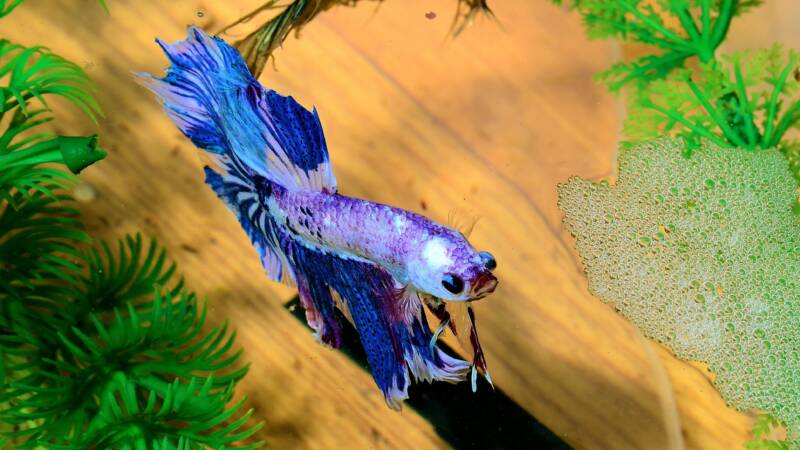
This variety provides a good anchor point for the bubble nest and a natural look for the tank.
Likewise, you can select tall growing plants that break the water surface, such as pennywort.
This plant can grow in the substrate or float on the surface.
It produces white flowers above the water line and its leaves provide excellent locations for your betta to build a bubble nest.
That said, plants are not completely necessary. Bettas can simply build nests in the corners of the tank!
What Triggers a Male Betta to Begin Building a Nest ?
Aside from the natural reproductive urge, male bettas can sometimes build nests in response to changes in their environment.
Temperature, water conditions, or even something new or absent from their habitat can trigger bubble nest construction.
In the wild, bettas can begin to build nests due to seasonal changes.
Do Females Ever Build Bubble Nests ?
No. This is typically an activity undertaken by the males.
Female bettas have been observed assisting in nest building when they are housed with a male in order to breed.
What are the Ideal Water Conditions for Bubble Nests ?
You should stay on top of your betta’s water conditions regularly, but even more so if you are planning to breed them.
Keep an eye on the levels of ammonia, nitrites, and nitrates. Nitrates are best below 20 ppm, and ammonia and nitrites should be 0 ppm.
Weekly water changes of around 25 percent and a quality filter will help. Water temperature and pH are important as well.
Keep the temperature between 74 and 81°F (23 to 27°C).
A neutral pH is best, but a range between 6 and 8 is acceptable.
Water hardness for bettas should be between 5 and 35 dGH, although they prefer it on the softer end.
To make the water softer, consider adding items that increase the level of tannins in the water.
Driftwood, Indian almond leaves, and live plants can help. These will tint the water slightly and soften it as well.
Take care to monitor the pH level, however, as tannins can lower the pH over time.
Your filter should be set to ensure minimal current in the tank, as that is what bettas prefer.
Low current and minimal splash will create the ideal conditions for bubble nest building.
Should You Remove a Bubble Nest?
If you do not intend to breed your bettas, you certainly can remove the bubble nest if it gets in the way of cleaning and maintaining your tank.
Building these nests is entertaining for your male betta, and their nests can frequently be disrupted in their natural habitat. Your male will simply begin construction of another.
If the nest is empty, you may want to remove it from time to time anyway, just to make sure that mold does not develop within the bubbles.
Closing Thoughts
Bubble nest construction is a natural part of your betta’s life cycle.
If you own a male betta for any length of time, you will likely see clusters of bubbles in your tank at some point.
A bubble nest is a sign of a healthy, happy fish doing what it does best!
Does your male betta regularly build bubble nests?
Do you leave it or remove it?
